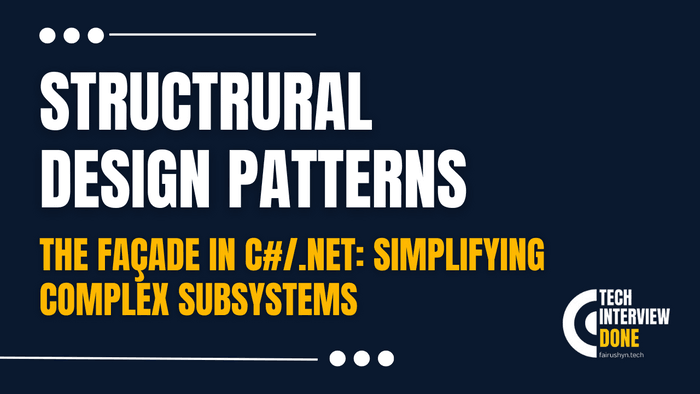The Façade in C#/.NET
Simplifying Complex Subsystems
3 min read · — #design-patterns#structrural-patterns#façade
Introduction
In the vast and evolving landscape of software engineering, design patterns serve as beacon lights, guiding developers through complex architectural challenges. Among these patterns, the Façade stands out for its simplicity and profound impact on how we approach software design. This post delves deep into the Façade pattern, illuminating its principles with C#/.NET examples tailored for experienced software engineers looking to refine their architectural toolkit. Whether preparing for a technical interview or seeking to enhance your project's structure, understanding the Façade pattern is indispensable.
The Essence of the Façade Pattern
At its core, the Façade pattern is about providing a simplified interface to a complex system. It's akin to a concierge in a grand hotel who ensures your stay is seamless, handling your complex requests with a simple smile and a nod. In software terms, the Façade abstracts the complexities of a system into a single, unified, and easy-to-use interface, allowing clients to interact with the system without being overwhelmed by its intricacies.
Real-World Scenario: E-Commerce System
Imagine an e-commerce system comprised of various subsystems: inventory, payment, and shipping. Each subsystem is complex, with its own set of interfaces. Without a Façade, clients (such as web controllers) would need intricate knowledge of these subsystems to operate them, leading to tightly coupled and hard-to-maintain code.
Implementing the Façade Pattern
Let's implement a Façade to simplify interactions with our e-commerce system.
Step 1: Identify the Complex Subsystems
Our first step is to outline the subsystems that the Façade will simplify. In our case, these are:
InventoryService: Manages stock levels and product information.PaymentService: Handles payment transactions.ShippingService: Manages the dispatch and delivery of orders.
Step 2: Design the Façade Interface
We then design a Façade interface that provides simplified methods to perform common tasks, such as placing an order. This interface does not expose the complexities of the underlying subsystems.
Step 3: Implement the Façade
public class ECommerceFacade
{
private InventoryService _inventoryService = new InventoryService();
private PaymentService _paymentService = new PaymentService();
private ShippingService _shippingService = new ShippingService();
public bool PlaceOrder(Product product, User user)
{
if (!_inventoryService.CheckStock(product))
{
return false;
}
if (!_paymentService.ProcessPayment(user, product.Price))
{
return false;
}
_shippingService.ScheduleDelivery(product, user.Address);
return true;
}
}In this implementation, PlaceOrder is a method that simplifies the process of ordering a product. It checks stock,
processes payment, and schedules delivery by interacting with the respective subsystems, thus hiding the complexity from
the client.
Benefits of the Façade Pattern
- Simplifies Interaction: Clients interact with a single, unified interface instead of multiple complex subsystems.
- Reduces Dependencies: Clients depend on the façade instead of the subsystems, promoting loose coupling.
- Enhances Flexibility: Changes to the subsystems do not affect clients, as the façade abstracts these details away.
Real-World Application: Integrating Third-Party Services
A common use case for the Façade pattern is when integrating third-party services into an application. Each service might have a complex API. By wrapping these APIs in a façade, you simplify the interaction for the rest of your application, isolating complexities and dependencies in one place.
Conclusion
The Façade pattern is a powerful tool in the software engineer's arsenal, offering a pragmatic approach to managing complexity through simplification. By mastering this pattern, you can enhance the design and maintainability of your applications, making them more robust and adaptable to change. Whether facing a technical interview or tackling a challenging project, the insights gained from understanding the Façade pattern will undoubtedly serve you well.
